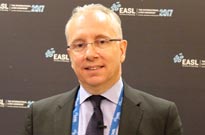
“虽然现有的直接作用抗病毒药物(DAA)对于丙型肝炎的治疗非常有效,利巴韦林(RBV)在这方面的应用较之前可能有所减少,但是,RBV对一些患者的治疗仍然是很重要的,仍占有一席之地。”--Jean-Michel Pawlotsky
DAA时代,利巴韦林在HCV治疗中的地位
与DAA的直接阻断病毒产生的作用不同,RBV可促进HCV感染的细胞的治愈,两种作用机制互不相同、互为补充。RBV目前仍用于治疗一些亚组患者人群,这些患者单用DAA治疗难以达到治疗效果。例如,基因1a型患者接受ombitasvir、paritaprevir和利托那韦(ritonavir)三联治疗时,仍需要应用RBV;而基因1b型患者应用该三联治疗,即可获得足够高的疗效。又如,经治患者应用索磷布韦(sofosbuvir)和来迪派韦(ledipasvir)时,必须联合应用RBV以提高持续病毒学应答(SVR)率。再有,高病毒载量的(HBV DNA>800 000 IU/mL)患者应用grazoprevir/elbasvir时,联合应用RBV非常重要。我们将应用RBV限于发生NS5A耐药的患者。
研究表明,发生Y93H突变的基因3型患者应用索磷布韦-velpatasvir时,联合应用RBV仍然有益;对于应用索磷布韦和一种NS5A抑制剂治疗的失代偿期肝硬化患者,联合应用RBV,也有助于提高SVR率。因此,目前虽然有许多DAA联合方案,对于一些DAA方案以及一些难治性患者,仍然需要联合应用RBV。
EASL推荐意见适用于世界各地
欧洲肝脏研究学会(EASL)关于治疗丙型肝炎的推荐意见旨在适用于世界所有地区。很明显,欧洲本身的各个国家就有许多不同的情况,但是EASL推荐意见与世界各地都有关,我们知道,许多地区,包括中国等亚洲国家都在应用EASL推荐意见。将这些推荐意见应用于当地时,需要考虑当地的流行病学、治疗药物以及照护的可及性、药物报销等情况,还要考虑当地的临床试验情况。但是,EASL推荐意见考虑到所有国家的情况,应用非常方便。
疫苗研发对于消灭HCV并非必要
世界卫生组织确定了至2030年消除丙型肝炎的目标。通过现有药物的治疗,相信我们可以实现这一目标,即对感染状况未知的HCV感染人群进行筛查和诊断,确定应该接受治疗的患者,提供有效的治疗方案。通过这些工作,使常见的疾病变为罕见病。加之,HCV疫苗的研发非常困难、花费巨大,近期研发出有效HCV疫苗的可能性较小,研发HCV疫苗必要性也不是非常迫切,将疫苗推向市场也是非常困难的。因此,总的来说,我认为HCV疫苗并非必须,不易确定哪些人群将从疫苗获益。当然,这些话题都颇具争议,但是应用现有的良好的药物,我们可以不需要疫苗就能够控制HCV感染问题。
专家简介:
Jean-Michel PAWLOTSKY,法国巴黎东区大学亨利蒙度医院医学教授,法国国家病毒性肝炎研究中心主任,EASL丙肝指南专家组主席,前任EASL秘书长(2005-2009),Hepatology杂志副主编(2001-2006),现任Gastroenterology杂志的副主编。已发表文章450篇。
Dr Pawlotsky: Ribavirin is still useful in the treatment of hepatitis C; probably less than it used to be previously, but still important in some patients. Ribavirin acts differently to the direct-acting antiviral drugs. The DAAs block virus production and ribavirin accelerates the cure of infected cells. They are two complementary mechanisms. Ribavirin is used in some patient subpopulationsthat need more than DAAs alone. For instance, we need to use ribavirin in genotype 1a patients who receive the triple combination of ombitasvir, paritaprevir and ritonavir, but you don’t have to use it for genotype 1b patients, where the triple combination is enough. With sofosbuvir and ledipasvir, we must use ribavirin in patients with treatment experience to improve the SVR. For grazoprevir/elbasvir, it is important to use ribavirin in patients who have a high viral load (>800000 IU/ml) and we restrict the use in these cases to those with NS5A resistance. For sofosbuvir-velpatasvir, ribavirin is still helpful in genotype 3 patients who have the Y93H mutation. So ribavirin is still being used with all the direct-acting combinations, but in some DA combinations and some difficult-to-cure patients, we have to use ribavirin. Ribavirin is also helpful to increase the results of therapy in patients with decompensated cirrhosis with sofosbuvir and an NS5A inhibitor.
Dr Pawlotsky: The EASL recommendations for the treatment of hepatitis C have been designed to be applicable everywhere in the world. Obviously, Europe itself is diverse with many different countries and circumstances, but the recommendations are relevant to any location around the world. We know these recommendations are applied in many areas, including in Asia. When I travel in Asia, including in China, I can see that they are used. They need to be adapted to local conditions, meaning considerations of the local epidemiology, the available drugs in that location, access to care, reimbursement and also any local clinical trials. But taking this information into consideration in any country, it is very easy to use the EASL recommendations. Importantly, we are launching at this meeting an APP called the EASL HCV Advisor. It is an application downloadable to your cellphone, where you can enter a patient’s characteristics and it will provide the treatment recommended by the EASL recommendations. Any physician in any country can use this at the bedside once the application is downloaded, so it is very easy to apply to local conditions.
Dr Pawlotsky: There is a goal for eradication by 2030 established by the World Health Organization. This goal is supposed to be achieved by therapy, meaning that we screen people who are infected who did not know they were infected, diagnose them, identify which patients should be treated and provide access to care. By doing this, the objective is to treat as many people as possible and make what is a frequent infection a rare infection. It is very unlikely there will be a vaccine. The technology is very difficult and there are cost deterrents. Also, the need is not that obvious given what we have in terms of drugs. Bringing a vaccine to market is also a very difficult thing to achieve. So overall, I don’t really think we need a vaccine. I don’t think it is easy to identify which population would benefit from a vaccination. These topics are, of course, all debatable, but we can manage without a vaccine. With the good drugs that we have, we should be able to live without a vaccine.